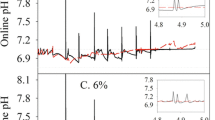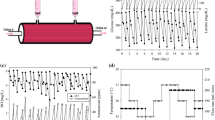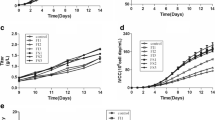Abstract
A high density hybridoma perfusion culture was established by separating and recycling cells from the product stream to the reactor using a simple external sedimentation-based separator — an inclined modified Erlenmeyer flask. After 3 weeks, when the optimal perfusion rate of 1.0 day−1 had been reached, viable cell density stabilized at around 10×106 cells ml−1, a level five times that obtained by simple batch culture. The efficiency of the separator was enhanced by cell flocculation. Specific antibody productivity, which was initially 0.4 μg 1×106 cells−1 h−1, decreased to half that value while cell density was increasing, but recovered to the initial level when the culture finally stabilized at a high cell density. During the final phase, when viable cell density and specific antibody production were high, there was a marked shift in metabolism. Consumption of the two most important substrates for energy generation, glucose and glutamine, caused their broth concentrations to decrease to 1.5 mM and 1 mM, respectively, from input medium concentrations of 25 mM and 10 mM, respectively. At the same time there was an increase in the specific production of glycine and aspartate, their broth concentrations reaching 1.5 mM and 0.02 mM, respectively. We suggest that this shift in metabolism results in enhanced production of ATP from glutamine. The specific glucose consumption and lactate production also indicate that there is a shift to more energy efficient metabolism. The mechanism whereby this leads to enhanced specific antibody production remains to be elucidated. Nevertheless, the combination of high cell density and enhanced productivity obtained with the present perfusion culture resulted in a high monoclonal antibody production −100 mg l−1 d−1.
Similar content being viewed by others
References
Andresen LO, Koch C, Sørensen BB and Emborg C (1989) Production of monoclonal antibodies against the enzyme nuclease fromSerratia marcescens and evaluation of the individual antibodies for their use in EIA and in affinity chromatography. Biotechnology Techniques 3: 407–411.
Batt BC, Davis RH and Kompala DS (1990) Inclined sedimentation for selective retention of viable hybridomas in a continuous suspension bioreactor. Biotechnol. Prog. 6: 458–464.
Boycott AE (1920) Sedimentation of blood corpuscles. Nature 104: 532.
Brown PC, Lane JC, Wininger MT and Chow R. (1991) Online removal of cells from continuous suspension cultures. In: Spier RE, Griffiths JB and Meignier B (eds.) Production of biologicals from animal cells in culture (pp. 416–420). Butterworth-Heinemann, Oxford.
Buell DN and Fahey JL (1969) Limited periods of gene expression in immunoglobulin-synthesizing cells. Science 164: 1524–1525.
Byars N and Kidson C (1970) Programmed synthesis and export of immunoglobulin by synchronized myeloma cells. Nature 226: 648–650.
De la Broise D, Noiseux M, Lemieux R and Massie B (1991) Long-term perfusion culture of hybridoma: A ‘grow or die’ cell cycle system. Biotechnol. Bioeng. 38: 781–787.
De la Broise D, Noiseux M, Massie B and Lemieux R (1992) Hybridoma perfusion systems: A comparison study. Biotechnol. Bioeng. 40: 25–32.
Esclade LRJ, Carrel S and Péringer P (1991) Influence of the screen material on the fouling of spin filters. Biotechnol. Bioeng. 38: 159–168.
Feder J and Tolbert WR (1983) The large-scale cultivation of mammalian cells. Sci. Am. 248: 24–31.
Frame KK and Hu W-S (1990) The loss of antibody productivity in continuous culture of hybridoma cells. Biotechnol. Bioeng. 35: 469–476.
Glacken MW (1988) Catabolic control of mammalian cell culture. Bio/Technology 6: 1041–1050.
Hansen HA and Emborg C (1992) Experimental design in the development and characterization of a high-performance liquid chromatographic method for amino acids. J. Chromatogr. 626: 171–180.
Himmelfarb P, Thayer PS and Martin HE (1969) Spin filter culture: The propagation of mammalian cells in suspension. Science 164: 555–557.
Hülscher M, Scheibler U and Onken U (1992) Selective recycle of viable animal cells by coupling of airlift reactor and cell settler. Biotechnol. Bioeng. 39: 442–446.
Kitano K, Shintani Y, Ichimori Y, Tsukamoto K, Sasai S and Kida M (1986) Production of human monoclonal antibodies by heterohybridomas. Appl. Microbiol. Biotechnol. 24: 282–286.
Krüger B (1990) Mass cultivation of shear sensitive hybridoma cell lines in stirred tank bioreactor. Chimicaoggi 8: 69–71.
Lassen KMK, de Caldeano PREC and Emborg C (1992) Methods for cell separation based on sedimentation. Biotechnology Techniques 6: 121–126.
Miller WM, Blanch HW and Wilke CR (1988) A kinetic analysis of hybridoma growth and metabolism in batch and continuous suspension culture: Effect of nutrient concentration, dilution rate, and pH. Biotechnol. Bioeng. 32: 947–965.
Persson B and Emborg C (1992) A comparison of three different mammalian cell bioreactors for the production of monoclonal antibodies. Bioprocess Eng. 8: 157–163.
Phillips PJ, Marquis CP, Barford JP and Harbour C (1991) An analysis of some batch and continuous kinetic data of specific monoclonal antibody production from hybridomas. Cytotechnology 6: 189–195.
Ramirez OT and Mutharasan R (1990) Cell cycle- and growth phase-dependent variations in size distribution, antibody productivity, and oxygen demand in hybridoma cultures. Biotechnol. Bioeng. 36: 839–848.
Ray NG, Karkare SB and Runstadler PW, Jr (1989) Cultivation of hybridoma cells in continuous cultures: Kinetics of growth and product formation. Biotechnol. Bioeng. 33: 724–730.
Reuveny S, Velez D, Miller L and Macmillan JD (1986) Comparison of cell propagation methods for their effect on monoclonal antibody yield in fermentors. J. Immunol. Meth. 86: 61–69.
Seamans TC and Hu W-S (1990) Kinetics of growth and antibody production by a hybridoma cell line in a perfusion culture. J. Ferment. Bioeng. 70: 241–245.
Takazawa Y, Tokashiki M, Hamamoto K and Murakami H (1988) High cell density perfusion culture of hybridoma cells recycling high molecular weight components. Cytotechnology 1: 171–177.
Tokashiki M, Arai T, Hamanoto K and Ishimaru K (1990) High density culture of hybridoma cells using a perfusion culture vessel with an external centrifuge. Cytotechnology 3: 239–244.
Tokashiki M and Arai T (1989) High density culture of mouse-human hybridoma cells using a perfusion culture apparatus with multi-settling zones to separate cells from the culture medium. Cytotechnology 2: 5–8.
Author information
Authors and Affiliations
Rights and permissions
About this article
Cite this article
Hansen, H.A., Damgaard, B. & Emborg, C. Enhanced antibody production associated with altered amino acid metabolism in a hybridoma high-density perfusion culture established by gravity separation. Cytotechnology 11, 155–166 (1993). https://doi.org/10.1007/BF00749005
Received:
Accepted:
Issue Date:
DOI: https://doi.org/10.1007/BF00749005




